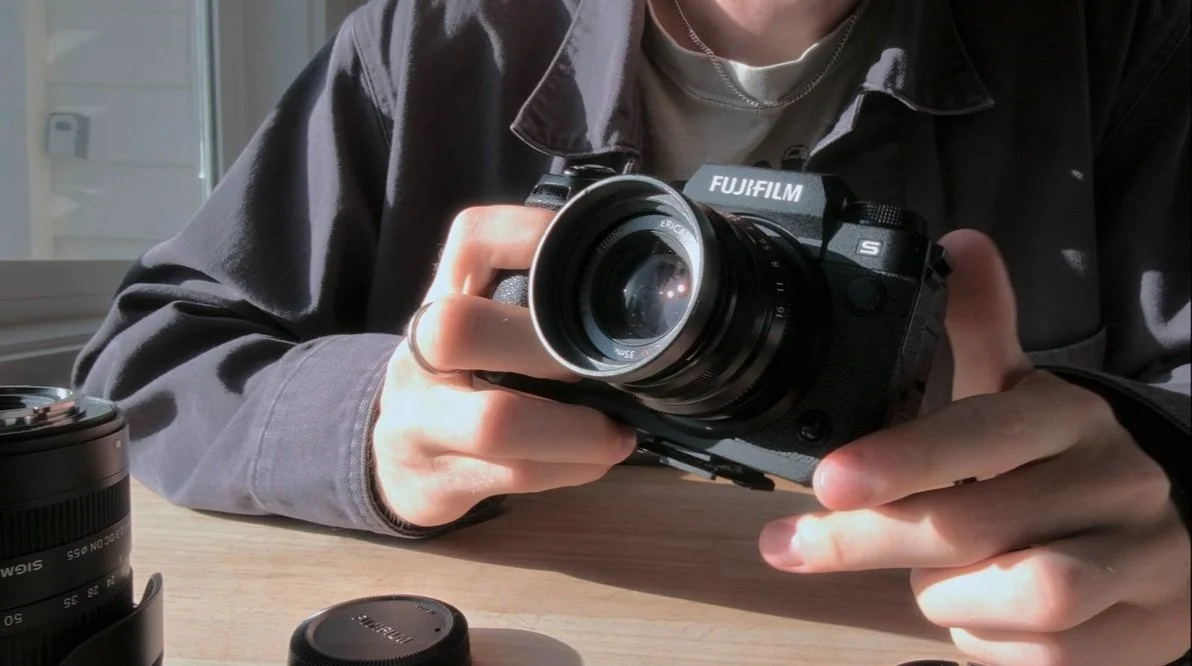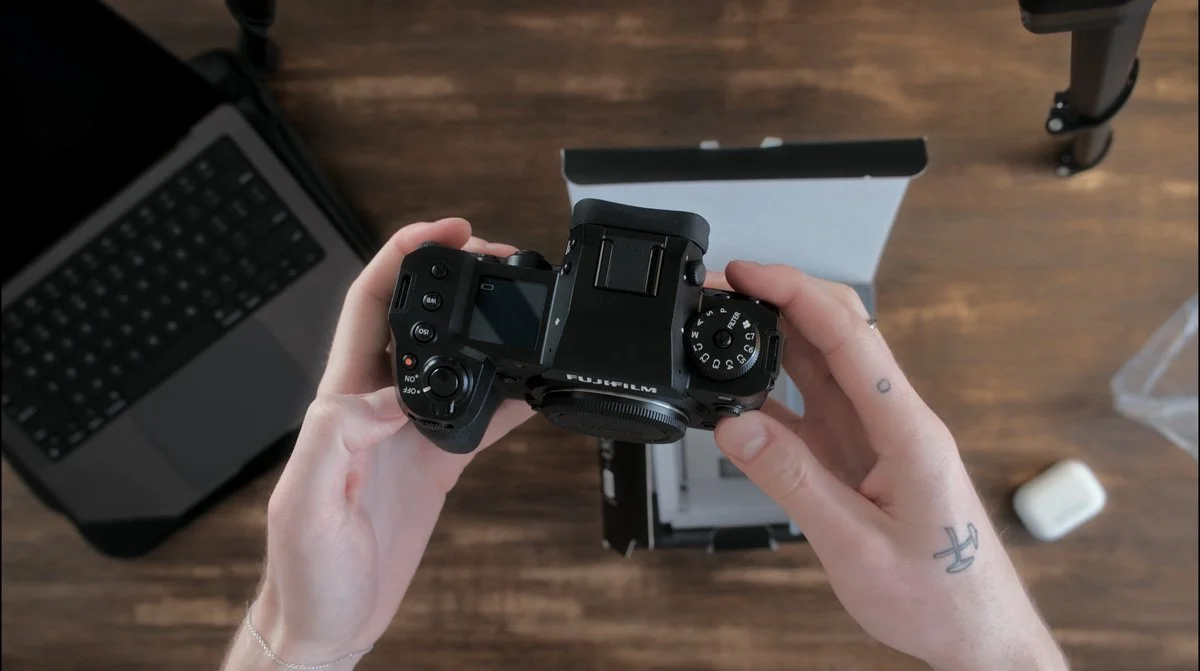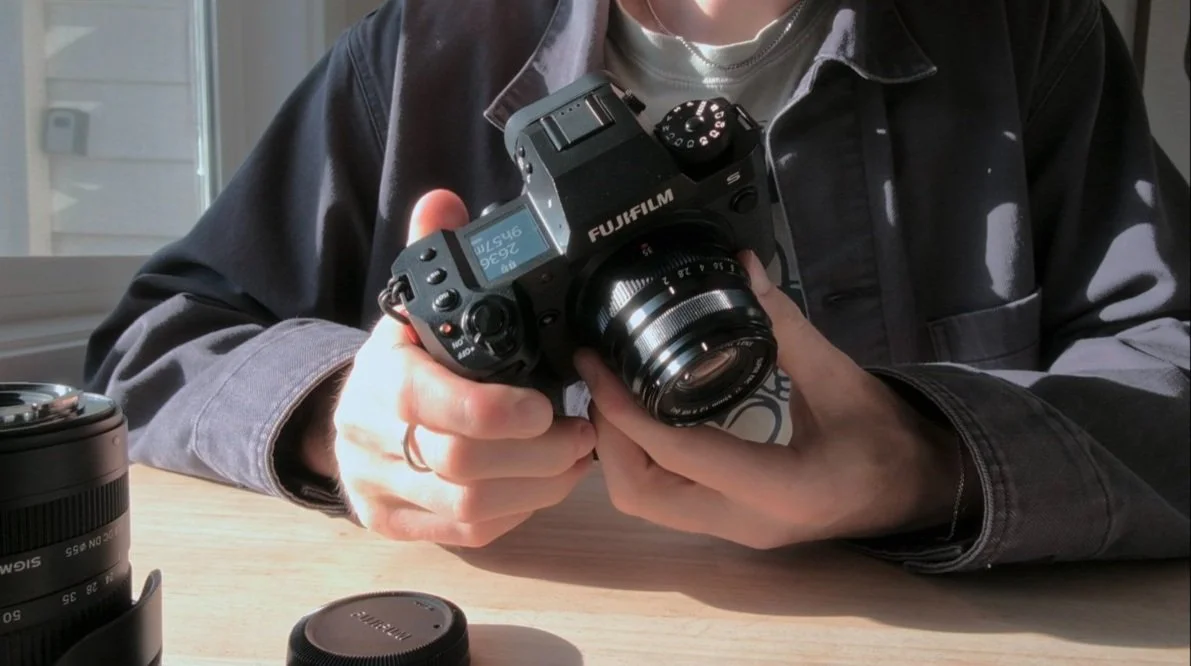FujiFilm X-H2s… It’s Complicated. First Impressions & Questions
A few months ago, I added the FujiFilm X-H2s, Fuji’s most advanced crop-sensor body, to my photography & videography kit.
Known for its impressive 40 fps burst, advanced video capabilities, and improved autofocus/technical performance over its predecessors, the X-H2s promised to resolve the frustrations inflicted upon me by other Fujifilm cameras such as the X-T5.
Now that I’ve put it through countless hours of everything from street photography to short filmmaking, it’s time to distill some of my observations into pros, cons, and open questions.
For sample footage and photos, watch the video version of this article.
Why I Considered the FujiFilm X-H2s
After two years with the X-T5, an excellent camera which fell flat for me despite its considerable strengths, I was debating staying in the Fujifilm ecosystem at all vs. going to one of the more advanced, pro-catering brands like Sony.
At least I’d never have to think about autofocus again and trust my camera’s auto exposure not to stab me in the back while filming, right?
But all I really wanted was a model within the Fuji lineup that could keep up in dynamic, hybrid photo/video environments and not entirely fall on its face as a stills camera.
You see, I’d prefer not to sell and replace all of my lenses, work with two different ecosystems, etc. It’s a much bigger commitment to switch brands than it is to trade camera bodies that share a lens mount.
The X-H2s (and the H2, I suppose) were simply the only remaining options for upgrading within the lineup, so the choice was actually relatively simple, as buying camera equipment goes.
Neutral Thoughts
There are some thoughts and feelings I have about the H2s so far that are neither positive nor negative. Before I go into the binary good/bad portion of this review, let’s discuss these.
Or don’t and jump straight to the positives/negatives. I’m not your mom.
This Camera is Overkill (For Me)
I have way more video capability on my hands here than I really needed, though I was very much aware that this would be the case ahead of time.
If I had to be critical, I’d say:
Positive: I have abundant headroom for growth, should I ever want to take video further
Negative: I feel as though I was pushed into a Ferrari because it had one or two features my Ford was missing. The H2s feels like the only Fujifilm hybrid body that offers some of the basic performance that comes standard in entry-level cameras from rival brands.
I didn’t want more camera than I needed, but I have much more than I need, nonetheless.
All because I was looking for something that rivals the competition, technically speaking.
That can’t be considered a bad thing; it’s just an observation about Fuji’s product lineup, and possibly my own flawed expectations or biases stemming from my use case as a traveling hybrid photographer.
Perhaps a different system is where I belong, or perhaps my expectations are unrealistic?
Maybe Fujifilm just isn’t targeting users like me, but then again, the H2s exists… for serious hybrid shooters.
So which is it, exactly?
Screen
I’m a way bigger fan of shooting stills using the articulating screen than I thought I’d be, again coming from the photography-first T5.
I don’t love that it has to fly out to the side in order to snap a photo at waist-level, and I do prefer the T5 tilt screen experience.
But what I actually want is for Fuji to give us a best-of-both-worlds screen like Sony’s A7RV. However, as this is not currently available, I’ll just say that it bothers me much less than I thought it would, and also manages to feel and look great. It’s sturdy and easy to work with.
Of course, as a YouTuber, hybrid shooter, I am so happy to finally be able to see what’s happening while in front of the camera without needing to use an app.
Monochrome/Top Screen
I have never cared less about a camera feature than I do about the little top screen. The only use I’ve found for it so far has been viewing the remaining charge on my battery while the screen is turned off.
That said, I do think it looks cool.
Would I prefer another customizable command wheel or two up there? I don’t know if it’s necessary, but it would possibly be a better use of that space on the top plate. I’m curious whether other H2s owners have found this little monitor indispensable.
Maybe I’m the only one out there who’s confused by its existence.
Aesthetics
I’m going to go on record saying I love how this camera looks.
Has nothing to do with how it works, of course, but in a sea of voices praising Fuji’s more retro-style cameras, I think they deserve a pat on the back for making a fantastic-looking camera in this more modern, SLR format as well.
Fuji’s designers are extremely talented.
Strengths & Highlights of the H2s So Far
Let’s begin on a positive note, shall we?
Exceptional Speed & Autofocus
The CFexpress card slot and stacked sensor make one hell of a pair. It’s capable of 40 fps continuous shooting without viewfinder blackout if you happen to be a sports photographer, or you’re out in the Sahara documenting a wildebeest migration.
For me, this just means that the thing is snappy, rolling shutter is all but GONE, read & buffer speeds are phenomenal, and autofocus/autoexposure now seem to perform sort of as well as its competitors.
Video Capabilities
Open gate footage, 6.2K oversampling, F‑Log 2, bitrates as high as 720. While I’m not the filmmaker who’ll be milking this thing for all its worth, the H2s has as much headroom as I expect to ever need.
IBIS
In that same vein, the IBIS is fantastic in this camera.
I don’t remember ever being as impressed with a camera feature as I am with the Fujifilm H2s stabilization. You can really tell a difference using an IBIS system in a photo-first camera like the X-T5, and one that was designed for video.
It’s not gimbal-smooth, but it’s just so good. Filming with this camera is really fantastic. I think about certain shots completely differently now.
Gone are the jittery, sticky camera movements of the X-T5. Now I am playing with all different kinds of panning shots, and even recording certain clips while walking (slowly & carefully, but still, walking!!). Camera movement actually looks good, relatively smooth, and natural. Even the bigger bumps and shakes have a more muted, cinematic feel compared to anything I’ve experienced up to this point.
Build Quality & Ergonomics
The X-H2s feels sturdier than the X-T5, with (allegedly) improved weather sealing and a HUGE grip that is comfortable in short-medium-length doses as long as your hands are on the larger side.
Plenty of custom buttons, and I love the custom shooting modes. I can be in 60fps one second, 24fps another, back to photo mode, over to my slow shutter/motion blur preset, all in the spin of a PASM wheel.
There are 7, so more than enough for most folks. I haven’t found a use for all of them yet.
Although I miss the dedicated shutter speed, ISO, exposure comp dials of the T5, I am getting used to the PASM-style design much more quickly than I thought, and I haven’t really missed those things as much as I expected to. I still have my X-Pro 3, of course, so maybe that’s what softens the blow in my case.
Resolution & Image Quality
If you’ve read or watched my work before, you’ll know how I feel about high-resolution sensors. This one comes in at a merciful (to my hard drive), sensible, middle-of-the-road 26 MP.
It’s sharp, has more than enough pixels, and looks fantastic in both photo and video mode. Easy A+ here. Of course, it makes sense for a video-centric camera to have a lower-res sensor.
I expect to remain with bodies that have an emphasis on video from now on. It’s much easier to take great photos with a video-centric camera than it is to take incredible videos with a photo-centric body.
Areas for Improvement
Size & Weight
At this size, I could easily have a full-frame camera. In fact, at the price point, size, and weight, I feel like I might as well make the jump and get all the low-light, image quality, dynamic range, and depth of field advantages that I’m NOT getting from the H2s.
This is, in my book, a big miss and a huge Fuji-ism.
What’s a Fuji-ism, you ask? A Fuji-ism is a completely inexplicable, yet critical flaw that makes an otherwise great camera appear fundamentally inferior to its competition.
Look, I’ll say two things here before you write a comment about why it needs to be so huge.
#1 - It’s not THAT big for a camera, generally speaking, though it does have a vaguely chunky feel. It’s just that it’s quite possibly the biggest, heaviest, chunkiest APS-C camera on the market
#2 - As you’ll know, I’m still considering simply heading back over to Sony, to get all those aforementioned benefits AND never think about autofocus again… in which case I should get used to having a bigger/heavier camera, permanently
All I’m saying is that if Fuji had managed to put this much power into a more compact body, they would have made something truly without competition.
Comparison photos borrowed from apotelyt.com
Sony’s 61 megapixel, full-frame A7RV is slightly smaller than the H2s.
Here, the A7RV is smaller, and yet has more screen! Plus, the RV screen manages to flip, tilt, twirl, somersault, and backflip. I’m begging for this design to be stolen by other manufacturers.
Okay, enough is enough.
I don’t pretend to have the blueprints for how exactly the H2s could have been 30% smaller. My key point is simply that there are far more advanced bodies with larger sensors aimed at the highest echelon of photographers and videographers that are about the same size as this body.
Yeah, the little f2 primes are ridiculous on the Fuji H2s, but I swear this lens looked totally normal on my T5!
This isn’t a vain or nitpicky con, by the way, it affects me day-to-day in several material ways.
I travel a lot (and also live out of a suitcase), so the amount of space this thing takes up is of particular importance to me.
I’m a street photographer, and the Fuji X-H2s draws much more attention than I’m used to. No more going under the radar with candid subjects, and I’m having to be a whole lot more confident about being noticed and confronted than I have been with smaller Fuji bodies.
I like to be out all day. I’m talking 8-12 hours shooting on and off. Never really noticed the T5 in my hands, but the H2s gets heavy and tiresome to carry after a full day out.
I carry a sling bag 99% of the time, not a backpack, so it’s more weight on one shoulder, and much less space for snacks. (Here’s my current favorite sling, by Bellroy, if you’re curious)
Battery Life
All that power does some damage to your batteries. You’ll still get a respectable amount of shots out of a single charge, but I’m not always going all day on one or two batteries like I did with the T5.
Nothing earth-shattering, but worth a mention.
Autofocus
Okay, I know I mentioned this one as a positive, too, but the AF still misses! Regularly!
Yes, it’s good now. Much, much better.
BUT the fact that it’s much better for a Fujifilm camera does not mean we’re out of the woods quite yet.
This system is still a few steps down from Sony, Canon, or Nikon. I know they’re working hard on it, but it needs to be better in order for Fuji to finally be taken more seriously by professionals. Having better specs is only going to improve your gear in the end. I’d rather see Fujifilm cameras be overkill than constantly underperform against the competition.
For what it’s worth, I believe the H2s has just brought Fuji’s autofocus up to about the same performance I had in my Sony a6400, which came out in 2019.
Will the FujiFilm X-H2s Stay in My Kit?
I’ve said it on Threads, and I’ll say it again here. If Fujifilm released an X-T6 with the same form factor as the T5, but with the sensor of the H2s, and the back screen of Sony’s A7RV that has forever ended the tilt/flippy screen debate, I’d buy 3 and never complain about a camera ever again.
But that’s a pipedream, and this is reality. I have to accept, at some point, that there’s no such thing as a perfect camera, and decide which compromises I’m willing to make, and which ones are dealbreakers.
I really do believe that at this size/weight, you and I might as well buy into a full frame system, though your lenses will also be larger, heavier, and more expensive as a consequence, so there remain a few advantages over full frame yet.
I also like that my lenses work with my secondary/photo-only camera- the X-Pro 3. Having redundancy in my gear and bodies that can share accessories and lenses is a huge bonus.
I’m not sticking with Fujifilm JUST to complain. I love this camera system with all my heart, and I want to see the progression from where we are now to being fully competitive with the other brands. Every bit of my criticism of Fujifilm comes from a deep-rooted passion for the cameras that they have created, and a desire to see them made even better.
Here’s the Bottom Line:
If you can’t take a good photo with this camera, or any camera in Fuji’s current lineup, that is 1000% user error. The X-H2s is fantastic at so many things, and a genuine marvel of technology and engineering.
I’m liking the H2s a lot. I’m enjoying shooting stills with it more than I expected to. I’m blown away by the video quality and performance. The IBIS is helping me create beautiful clips that I could not achieve with past setups.
I have everything I need in my hands at this point. The rest is mainly wishful thinking, or possibly unreasonable to expect out of a single camera body.
After all, they aren’t designed specifically for me.
Fujifilm cameras hold their value well, so I’m going to give it about a year to see what Fujifilm puts out next, and also assess how my relationship with the H2s develops over tens of thousands of photos and videos this year.
If I sell it, the investment will have been worth the year of trial and error.
The way I look at it is this: I’m “renting” the camera throughout 2025 for whatever the loss I take selling it might be, and I think it’s important to look at gear as a means to an end, rather than getting attached to it.
Unless it’s a dusty film camera that’s older than I am, that is.













